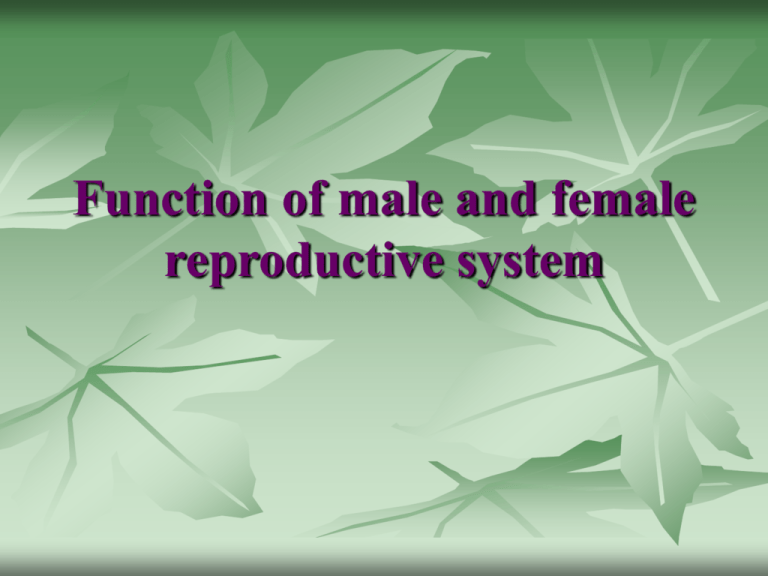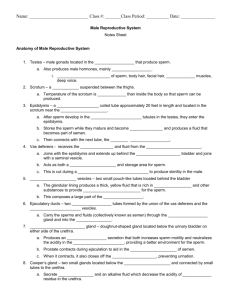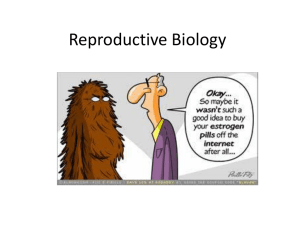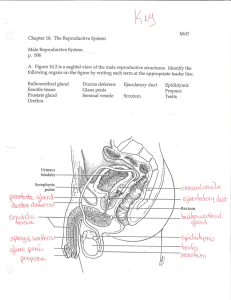Function of male and female reproductive system
advertisement

Function of male and female reproductive system Formation of sexual fitches of the organism at fetal period In fetus testosterone is secreted by genital ridges under influence of male chromosome “Y” at 7th week of fetation. Later fetal testes secrete testosterone under influence of human chorionic gonadotropin from placenta. Action of testosterone in fetus causes development of penis, scrotum, prostate, seminal vesicles and male genital duct; suppresses formation of female genital organs; causes descent of testes through inguinal canal into scrotum during last two months of gestation. Regulation of testosterone in fetus occurs due to human chorionic gonadotropin from placenta that causes Laydig cell formation in testes and so testosterone secretion. Absence of “Y” chromosome and testosterone in blood results in development of female fetus. Peculiarities of pubertal and prepubertal periods Puberty period in male is period, during which secondary sexual characters begin to develop and capability of sexual reproduction is attained. It begins normally at age of 12-13. Processes probably in amigdala causes hypothalamus to begin secretion luteinising human releasing hormone that stimulates anterior pituitary glandto secrete luteinising hormone and follicle stimulating hormone and then testosteron secretion by Leydig cells. Peculiarities of pubertal and prepubertal periods Laydig cells that secret testosterone are non-existent in childhood, but abundant in newborn male infant and in adult male after puberty. Testosterone in target cells is converted into dihydrotestosterone and 5-alfaandrostanediol. Some actions of testosterone depend upon this convertion, while others do not. Testosterone that is not uptaken by target cells is degraded by liver into androsterone, dehydroepiandrosterone and conjugated as glucuronides or sulfates. Conjugated products of degraded testosterone are excreted in bile or in urine. Mechanism of testosterone action is proteinformation mechanism. Peculiarities of pubertal and prepubertal periods Characters of body, which make their appearance under influence of sex hormones at puberty are called secondary sexual characters. In male they include: 1) body hears – testosterone causes increase hair growth over pubis, male pattern is convex, upward along linea alba, on chest, on face and on back; 2) baldness – testosterone causes decrease hair growth on top of head, producing baldness; 3) voice – testosterone causes hypertrophy of pharyngeal mucosa and enlargement of larynx, which first causes “cracking voice”, and then causes typical masculine bass voice; 4) skin – testosterone increases skin thickness, secretion of sebaceous gland and acne; 5) subcutaneous fat – testosterone decreases subcutaneous fat. Peculiarities of pubertal and prepubertal periods Testosterone increases spermatogenesis in seminiferous tubules. Anabolic effect of testosterone – increases protein synthesis, causes positive nitrogen balance, decreases blood urea level, increases muscle development and creatin content in muscles, increases bone thickness, narrows pelvic outlet and lengthens it, increases strength of pelvis for load bearing. Testosterone due to metabolic effect increases also red blood cells count, Na and water reabsorbtion in distal tubuls in kidney, increases libido (sexual appetite) by directly acting on central nervous system. Peculiarities of pubertal and prepubertal periods Period during which monthly sexual cycles begin in female is called as puberty period begins at 11-15 years of life. At this age anterior pituitary gland begins to secrete luteinising hormone and follicle stimulating hormone that causes changes in ovaries and uterus that result in monthly sexual cycles in female. During childhood granulosa cells secrete oocyte maturation-inhibiting factor that keeps ovum in its primordial state. There are two types of ovarian hormones: estrogenes (most important is estradiol) and progestins (most important is progerterone). Action of estrogenes Action of estrogenes is based on protein formation mechanism, so slight positive nitrogen balance develops, fat desposition in subcutaneous tissue, breast, buttocks and thighs occur, in blood cholesterole level decreases and fibrinogen level rises. Estrogenes cause increase in size and wall masculature in vagina; simple cuboidal epithelium is converted to stratified epithelium, which is more resistant to trauma and infections. Estrogenes increase glycogene disposition, so pH in vagina becomes more acidic due to conversion of glycogen into lactic acid by bacteria. External genitalia increase in size and increases fat deposition in mons pubis and labia majora under the influence of estrogenes. Increase of uterus in size, its vascularity, proliferation of epithelium and proliferation of glandular tissue in fallopian tubes are also occurs. Female reproductive system Video Action of estrogenes Estrogenes inhibit luteinizing hormone and follicle stimulating hormone secretion by negative feedback mechanism, so ovarian function decreases. This effect is used as oral contraception. Secondary sexual characters are also get developed due to estrogenes. They initiate growth of breast, cause development of stroma and duct system, cause fat deposition in breast, causes skin to become smooth and soft due to increase skin vascularity, broadens pelvis, larynx retains its prepubertal size and voice remains highpitched. Progesterone Progesterone promotes secretory changes in uterine endometrium and fallopian tubes during secretory faze of menstrual cycle, promotes development of lobule and alveoli in breast; causes alveolar cells to proliferate, enlarge and become secretory. Onset of menstruation is called menarche. Progesterone inhibits ovulation by inhibiting release of luteinizing hormone and follicle stimulating hormone. Progesterone causes also slight retention of Na+, Cl- and water from renal tubules and completes aldosterone in this action. Formation and mechanism of sexual motivation In male pathway of afferent sexual sensations includes the next: psychic or physical stimulation of sensory end organs, spreading impulses by pudendal nerve, sacral plexus, sacral portion of spinal cord and then undefined areas of cerebrum and limbic system. Afferent pathway in female includes psychic or sexual stimulation, spreading excitation through pudendal nerve to sacral segment of spinal cord and through analyzing systems to limbic system. Anatomy of the Male Reproductive System The male reproductive system consists of the testes (sing., testis), a series of ducts, accessory glands, and supporting structures. The ducts include the epididymides (sing., epididymis), ductus deferentia (sing., deferens; also vas deferens), and urethra. Accessory glands include the seminal vesicles, prostate gland, and bulbourethral glands. Supporting structures include the scrotum and penis Sagittal section of the male pelvis showing the male reproductive structures Sperm cells are very temperature-sensitive and don’t develop normally at usual body temperatures. The testes and epididymides, in which the sperm cells develop, are located outside the bodycavity in the scrotum, where the temperature is lower. The ductus deferentia lead from the testes into the pelvis, where they join the ducts of the seminal vesicles to form the ampullae. Extensions of the ampullae, called the ejaculatory ducts, pass through the prostate and empty into the urethra within the prostate. The urethra, in turn, exits from the pelvis and passes through the penis to the outside of the body. Scrotum The scrotum contains the testes and is divided into two internal compartments by an incomplete connective tissue septum. Externally, the scrotum is marked in the midline by an irregular ridge, the raphe, which continues posteriorly to the anus and anteriorly onto the inferior surface of the penis. The outer layer of the scrotum includes the skin, a layer of superficial fascia consisting of loose connective tissue, and a layer of smooth muscle called the dartos (dartoЇs; to skin) muscle. Perineum The area between the thighs, which is bounded by the symphysis pubis anteriorly, the coccyx posteriorly, and the ischial tuberosities laterally, is called the perineum. The perineum is divided into two triangles by a set of muscles, the superficial transverse and deep transverse perineal muscles, that runs transversely between the two ischial tuberosities. The anterior, or urogenital triangle, contains the base of the penis and the scrotum. The smaller posterior, or anal, triangle, contains the anal opening. The testes are small ovoid organs, each about 4–5 cm long, within the scrotum. They are both exocrine and endocrine glands. Sperm cells form a major part of the exocrine secretions of the testes, and testosterone is the major endocrine secretion of the testes. Testicular Histology The outer part of each testis is a thick, white capsule consisting of mostly fibrous connective tissue called the tunica albuginea. Connective tissue of the tunica albuginea enters the testis and forms incomplete septa. The septa divide each testis into about 300–400 coneshaped lobules. The substance of the testis between the septa includes two types of tissue: seminiferous (semi-nifer-u˘s; seed carriers) tubules in which sperm cells develop and a loose connective tissue stroma that surrounds the tubules and contains clusters of endocrine cells called interstitial cells, or Leydig cells, which secrete testosterone. Descent of the Testes (Approximately 2 months) The testes develop as retroperitoneal organs in the abdominopelvic cavity, and each testis is connected to the scrotum by a gubernaculum a fibromuscular cord. Descent of the Testes (Approximately 3 months) The testes move from the abdominal cavity through the inguinal canals to the scrotum. Cryptorchidism is failure of one or both of the testes to descend into the scrotum. Descent of the Testes (Approximately birth) As they move into the scrotum, each testis is preceded by an outpocketing of the peritoneum called the process vaginalis. The superior part of each process vaginalis usually becomes obliterated, and the inferior part remains as a small, closed sac, the tunica vaginalis. Descent of the Testes (Adult) The tunica vaginalis surrounds most of the testis in much the same way that the pericardium surrounds the heart. The visceral layer of the tunica vaginalis covers the anterior surface of the testis, and the parietal layer lines the scrotum. The tunica vaginalis is a serous membrane consisting of a layer of simple squamous epithelium that rests on a basement membrane. Inguinal Hernia Normally, the inguinal canals are closed, but they do represent weak spots in the abdominal wall. Inguinal hernias are abnormal openings in the abdominal wall in the inguinal region through which structures such as a portion of the small intestine can protrude. These hernias can be quite painful and even very dangerous, especially if a portion of the small intestine is compressed so its blood supply is cut off. Fortunately, inguinal hernias can be repaired surgically. Males are much more prone to inguinal hernias than are females because a male’s inguinal canals are larger and weakened because the testes pass through them on their way into the scrotum. Sperm Cell Development A cross section of a mature seminiferous tubule reveals the various stages of sperm cell development, a process called spermatogenesis. In addition, tight junctions between the sustentacular cells form a blood-testes barrier, which isolates the sperm cells from the immune system The seminiferous tubules contain two types of cells, germ cells and sustentacular, or Sertoli cells. The sustentacular cells are also sometimes referred to as nurse cells. Testosterone Testosterone, produced by the interstitial cells, passes into the sustentacular cells and binds to receptors. The combination of testosterone with the receptors is required for the sustentacular cells to function normally. In addition, testosterone is converted to two other steroids in the sustentacular cells: dihydrotestosterone and estrogen. The sustentacular cells also secrete a protein called androgenbinding protein into the seminiferous tubules. Testosteroneand dihydrotestosterone bind to androgen-binding protein and are carried along with other secretions of the seminiferous tubules to the epididymis. Estradiol and dihydrotestosterone may be the active hormones that promote sperm cell formation. Scattered between the sustentacular cells are smaller germ cells from which sperm cells are derived. The germ cells are arranged so that the most immature cells are at the periphery and the most mature cells are near the lumen of the seminiferous tubules. The most peripheral cells, those adjacent to the basement membrane of the seminiferous tubules, are spermatogonia, which divide by mitosis. Spermatogenesis Some of the daughter cells produced from these mitotic divisions remain spermatogonia and continue to produce additional spermatogonia. The others divide through mitosis and differentiate to form primary spermatocytes. Meiosis Meiosis begins when the primary spermatocytes divide. Each primary spermatocyte passes through the first meiotic division to become twosecondary spermatocytes. Each secondary spermatocyte undergoes a second meiotic division to produce two even smaller cells called spermatids. Each spermatid undergoes the last phase of spermatogenesis called spermiogenesis to form a mature sperm cell, or spermatozoon. Each spermatid develops a head, midpiece, and a tail, or flagellum. After their release into the seminiferous tubules, the sperm cells pass through the tubuli recti to the rete testis. From the rete testis, they pass through the efferent ductules, which leave the testis and enter the epididymis to join the duct of the epididymis. The sperm cells then leave the epididymis, passing through the ductus epididymis, ductus deferens, ejaculatory duct, and urethra to reach the exterior of the body. Urethra The male urethra is about 20 cm long and extends from the urinary bladder to the distal end of the penis. The urethra is a passageway for bothurine and male reproductive fluids. The urethra is divided into three parts: the prostatic part, the membranous part, and the spongy part. The prostatic (pros-tatik) urethra is connected to the bladder and passes through the prostate gland. Fifteen to 30 small ducts from the prostate gland and the two ejaculatory ducts empty into the prostatic urethra. The membranous urethra is the shortest part of the urethra and extends from the prostate gland through the perineum, which is part of the muscular floor of the pelvis. The spongy urethra, also called the penile urethra, is by far the longest part of the urethra and extends from the membranous urethra through the length of the penis. Penis The penis contains three columns of erectile tissue, and engorgement of this erectile tissue with blood causes the penis to enlarge and become firm, a process called erection. The penis is the male organ of copulation through which sperm cells are transferred from the male to the female. Two of the erectile columns form the dorsum and sides of the penis and are called the corpora cavernosa. The third column, the corpus spongiosum Seminal Vesicles The seminal vesicles are sac-shaped glands located next to the ampullae of the ductus deferentia. Each gland is about 5 cm long and tapers into a short duct that joins the ductus deferens to form the ejaculatory duct. The seminal vesicles have a capsule containing fibrous connective tissue and smooth muscle cells. Prostate Gland The prostate gland consists of both glandular and muscular tissue and is about the size and shape of a walnut; that is, about 4 cm long and 2 cm wide. It is dorsal to the symphysis pubis at the base of the urinary bladder, where it surrounds the prostatic urethra and the two ejaculatory ducts. The gland is composed of a fibrous connective tissue capsule containing distinct smooth muscle cells and numerous fibrous partitions, also containing smooth muscle, that radiate inward toward the urethra. Covering these muscular partitions is a layer of columnar epithelial cells that form saccular dilations into which the columnar cells secrete prostatic fluid. Fifteen to 30 small prostatic ducts carry these secretions into the prostatic urethra. Male reproductive irgans Video Sexual reaction in male Male sexual act includes such processes: 1) erection; 2) lubrication; 3) emission; 4) ejaculation. Psychical stimuli lead to excitation of corresponding centers in limbic system. Physical sexual stimulation cause afferent impulse through pudendal nerve integrated in sacral segment. Then afferent impulses through nervi erigentes from pelvic parasympathetic nerve spread to penis and cause delation of arteries. Arterial blood builds up under high pressure in erectile tissue and venous outflow occluded. So, erectile tissue balloon up, penis become hard and elongated that called as erection. Same parasympathetic impulses that cause erection also stimulate urethral and bulbourethral glands to secrete mucous that lubricate during intercourse. When sexual stimulation becomes extremely intense, reflex centers of spinal cord (L1-2) send sympathetic impulsesthrough hypogastric plexus that cause contraction of vas deference, ampulla, prostate and lastly seminal vesicle. So, semen emitted into internal urethra. After this afferent signalsthrough pudendal nerve cause sympathetic stimulation and efferent signals from sacral sigment of spinal cord through hypogastric plexus lead to contraction of internal genital organs that cause rhythmic increase in pressure of internal urethra from outside. This provides ejaculation of semen from internal urethra into deep vagina. Extremely pleasurable sensations felt during emission and ejaculation, are called male orgasm or male climax. Sexual reaction in female Female sexual act includes such processes: 1) stimulation; 2) erection; 3) lubrication; 4) climax. Psychical stimuli lead to excitation of corresponding centers in limbic system. Physical sexual stimulation cause afferent impulse through pudendal nerve integrated in sacral segment. Parasympathetic signals that pass through nervi erigenes dilate arteries of erectile tissue in introitus and clitoris. So, blood accumulates in erectile tissue. Same parasympathetic signals also pass to Bartholin’s glands beneath labia minora and vaginal epithelium that cause them to secrete mucus, which is essential for massaging action. Than during climax perineal muscles contract rhythmically.








